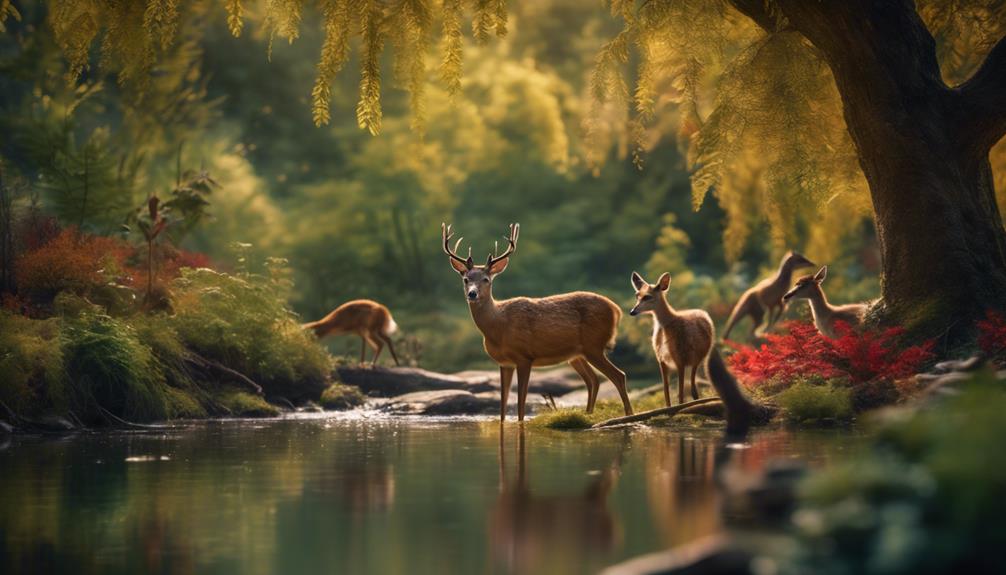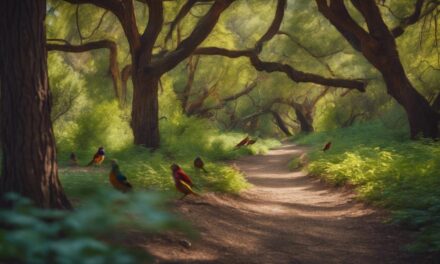When you take a leisurely walk through Barstow Woods Park, you'll have the chance to appreciate the wonders of nature. You might catch a glimpse of vibrant Yellow Warblers flitting through the trees or hear the rhythmic drumming of Downy Woodpeckers marking their territory. Don't overlook the grassy areas where Song Sparrows thrive or the skies where Red-tailed Hawks soar majestically. Near the ponds, you could spot Painted Turtles basking in the sun. There's so much more to discover, each corner of the park teeming with life waiting for your quiet observation.
Key Takeaways
- Various warbler species, including Yellow Warbler and Black-throated Green Warbler, can be seen during migration seasons.
- Common woodpeckers such as Downy, Hairy, and Red-bellied Woodpeckers exhibit drumming behavior.
- Eastern Screech-Owl and Great Horned Owl are notable nocturnal birds of prey in the park.
- Red-tailed Hawk and Cooper's Hawk are frequently observed, especially during migration periods.
- Painted turtles and snapping turtles are commonly found near the park's ponds.
Warblers
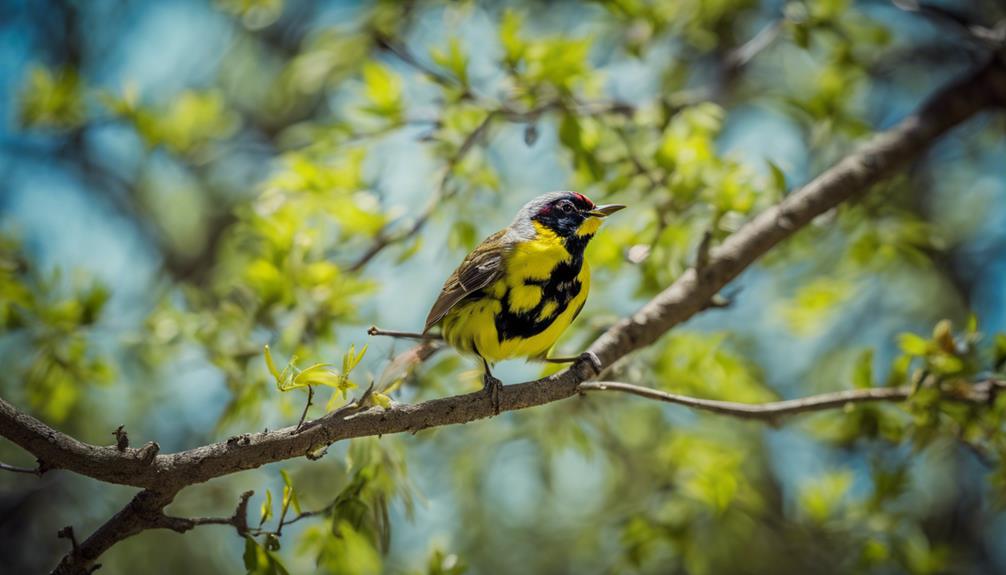
You'll find that Barstow Woods Park is an exceptional location to observe various warbler species during their migration seasons. These small, colorful songbirds captivate birdwatchers with their vibrant plumage and melodious songs. The diversity of warblers in Barstow Woods Park provides a unique opportunity for detailed observation and study.
Among the most notable species you can spot here are the Yellow Warbler, Blackburnian Warbler, and Black-throated Green Warbler. Each species has its distinct characteristics. The Yellow Warbler is easily identifiable by its bright yellow feathers and sweet, whistling song. The Blackburnian Warbler, on the other hand, stands out with its striking orange throat and contrasting black and white markings. The Black-throated Green Warbler is recognized for its olive-green upperparts and distinctive black throat.
Warblers are primarily insectivorous, meaning they feed on insects. You'll often see them flitting through trees and shrubs in search of food, making quick, agile movements. This behavior not only aids in their insect hunting but also provides birdwatchers with ample opportunities to observe their feeding habits and intricate flight patterns.
As you navigate through Barstow Woods Park, pay close attention to the dense foliage and canopy layers. Warblers are known to be elusive, often blending seamlessly into their surroundings. Early morning hours are particularly rewarding for observations, as these birds are most active during this time.
The influx of birdwatchers to Barstow Woods Park during migration seasons underscores the park's importance as a hotspot for avian biodiversity. With patience and keen observation, you'll likely experience the thrill of spotting these beautiful warbler species in their natural habitat.
Woodpeckers
You'll notice woodpeckers like the Downy and Hairy Woodpecker by their distinct drumming sounds as they peck on trees.
This behavior isn't just for foraging insects but also for marking territory.
The park's wooded areas make it an ideal habitat for these species, providing ample opportunities for observation.
Common Woodpecker Species
Discover the fascinating world of woodpeckers at Barstow Woods Park, where species like the Downy Woodpecker, Hairy Woodpecker, and Red-bellied Woodpecker thrive. These woodpeckers are an essential part of the park's ecosystem in the United States, and they're easily spotted in the wooded areas.
Downy Woodpeckers are the smallest of the trio, with a length of about 6-7 inches. You'll recognize them by their black and white plumage and their ability to forage for insects under bark.
Hairy Woodpeckers are similar in appearance but are larger, measuring around 9-10 inches. They've a strong bill, perfect for drilling into tree trunks to find food.
The Red-bellied Woodpecker, despite its name, has more prominent red on its head than its belly and is known for its striking black and white barred back.
When observing these birds, consider:
- Foraging Behavior: Watch them peck under bark and in crevices for insects.
- Habitat: Look in wooded areas where they're most active.
- Plumage Patterns: Note the distinctive black and white plumage, making identification easier.
Identifying Woodpecker Sounds
While observing woodpeckers at Barstow Woods Park, paying attention to their distinct drumming sounds and vocalizations can greatly aid in identifying different species. Woodpeckers create unique drumming patterns by pecking on trees, a behavior primarily used to communicate and establish territory. Each species has its own rhythm and frequency, making it possible to distinguish between them.
For instance, the rapid, repeated drumming of a Downy Woodpecker differs significantly from the slower, more deliberate taps of a Hairy Woodpecker.
Vocalizations also play an essential role in identification. Woodpeckers produce a variety of calls, from sharp 'pik' sounds to complex chatters. These vocal cues can help you locate the birds, especially in dense areas of the park's natural area. Understanding these sounds can enrich your birdwatching experience, revealing insights into their behavior and habitat preferences.
Whether near the dog park or by the picnic tables, listen for the rhythmic drumming and distinctive calls. Recognizing these auditory patterns won't only help in spotting woodpeckers but also deepen your appreciation for their communicative and territorial behaviors in the diverse habitats of Barstow Woods Park.
Sparrows
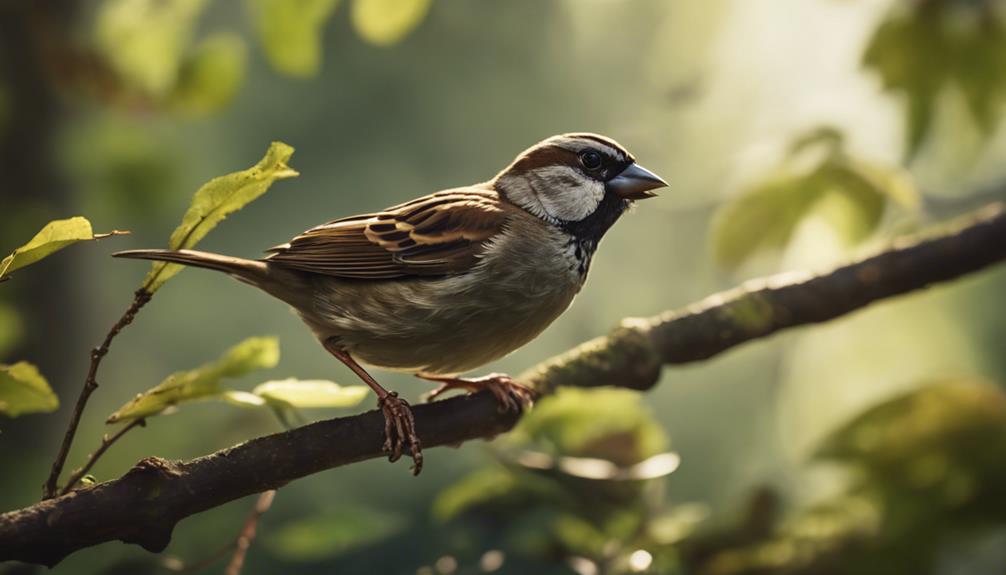
You'll find various sparrow species at Barstow Woods Park, including Song Sparrows and Chipping Sparrows. Observing their distinctive markings and behaviors can help you identify them, whether they're foraging on the ground or flitting among trees.
These small, brownish birds thrive in the park's grassy and wooded areas, contributing to the park's rich biodiversity.
Identifying Sparrow Species
Identifying sparrow species requires careful observation of their distinctive facial markings, breast patterns, and tail shapes. Barstow Woods Park is a great place to practice these skills, given the variety of sparrows that frequent the area. You'll notice subtle differences among common species like House Sparrows, Song Sparrows, Chipping Sparrows, and White-throated Sparrows.
To accurately identify sparrows, pay attention to the following:
- Facial Markings: House Sparrows exhibit a grey crown and black bib, while White-throated Sparrows have a striking white throat patch and yellow lores. Song Sparrows feature a dark malar stripe that contrasts with their streaked breast.
- Breast Patterns: Song Sparrows are known for their heavily streaked breasts with a central dark spot, contrasting with the Chipping Sparrow's cleaner, plain breast.
- Tail Shapes: Notice the tail shapes; Song Sparrows have rounded tails, whereas Chipping Sparrows display more forked tails.
Sparrow Habitats Explained
Sparrows thrive in various habitats, from the open grasslands and dense woodlands to bustling urban areas, making them adaptable and widespread. In Barstow Woods Park, you'll notice sparrows' nesting habits reflect their versatility. They build cup-shaped nests using grass, twigs, and feathers, often concealed in shrubs or trees to protect their young. In urban environments, they ingeniously utilize man-made structures, adding a touch of nature to cityscapes.
Their feeding behavior is equally diverse. Sparrows primarily eat seeds but aren't picky eaters. They also consume insects, fruits, and even human-provided food like breadcrumbs, seamlessly integrating into different ecosystems. Their adaptability extends to their migration patterns, with some species being year-round residents while others migrate seasonally, following food availability and climate changes.
Observing sparrows, you'll see remarkable plumage variations. Many species display brown or gray feathers with streaks or spots, which aid in camouflage. These birds are social creatures, often seen in flocks, chirping cheerfully. Their social interactions are evident as they forage together or engage in communal roosting.
In essence, sparrows' adaptability in nesting habits, feeding behavior, and social interactions highlight their resilience and charm, making them a delightful presence in both natural and urban settings.
Owls
Barstow Woods Park hosts several owl species, including the Eastern Screech-Owl and the Great Horned Owl, which you can often spot in the wooded areas, particularly near dawn or dusk. Observing owl behavior can be both thrilling and educational. These nocturnal birds of prey exhibit fascinating hunting techniques, often gliding silently through the trees to catch their prey. Their keen sense of hearing and exceptional night vision make them formidable hunters.
Understanding owl nesting habits is important for those interested in these birds. The Eastern Screech-Owl tends to nest in tree cavities, abandoned woodpecker holes, or even nest boxes, making them relatively easy to locate if you know where to look. In contrast, the Great Horned Owl prefers larger, more secluded areas, often repurposing old nests built by other large birds like hawks. Nesting season typically occurs in early spring, providing an excellent opportunity to witness these magnificent creatures in their natural habitat.
Efforts in owl conservation are vital to maintaining the population of these incredible birds. Barstow Woods Park participates in various initiatives to protect owl habitats and promote their longevity in the area. Educating the public about the importance of preserving natural nesting sites and minimizing human disturbance are key components of these efforts.
Here are three tips for spotting owls at Barstow Woods Park:
- Listen for their distinctive calls or hoots, especially near dawn or dusk.
- Look for nesting sites in tree cavities or abandoned nests during the early spring.
- Bring binoculars for a closer view without disturbing the owls.
Hawks
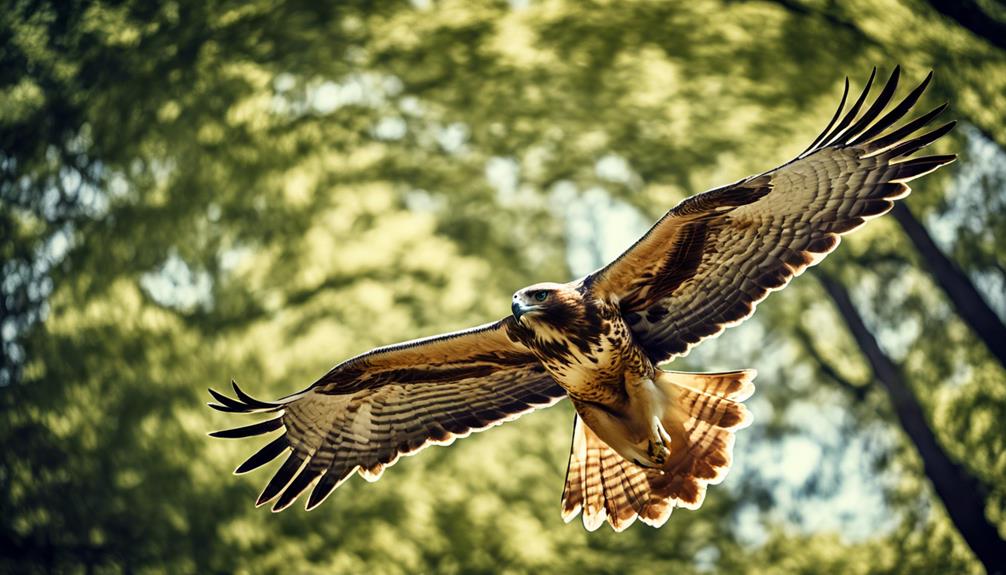
Hawks in Barstow Woods Park, such as the Red-tailed Hawk and Cooper's Hawk, can often be observed soaring gracefully above the treetops, scanning the ground for prey. These raptors are a magnificent sight, with their keen eyesight and powerful flight making them skilled hunters. You'll frequently see them perched in tall trees or gliding over open spaces, searching for small mammals, birds, and insects.
Hawk nesting in Barstow Woods Park is particularly fascinating. Red-tailed Hawks typically build large nests high in the trees, using sticks and twigs to create a sturdy platform. Cooper's Hawks, on the other hand, prefer dense wooded areas for their nests, often choosing coniferous trees for added cover. Both species demonstrate strong territorial behavior during the breeding season, vigorously defending their nesting sites from potential threats.
Understanding hawk migration patterns is essential for avid birdwatchers. Red-tailed Hawks are partial migrants, meaning some will migrate while others remain in the area year-round, depending on food availability. Cooper's Hawks, however, tend to migrate southward during the colder months, returning to Barstow Woods Park in the spring. Monitoring these patterns can give you a better chance of spotting these birds during their seasonal movements.
Hawk conservation efforts are vital in maintaining the ecological balance within the park. These efforts include protecting nesting sites, minimizing habitat destruction, and monitoring populations to make sure their numbers remain stable. By supporting these measures, you can help preserve the integral role hawks play in controlling rodent populations and maintaining the health of Barstow Woods Park's ecosystem.
Observing hawks in their natural habitat offers a unique glimpse into the intricate balance of nature, enriching your visit to Barstow Woods Park.
Ducks
You'll find a diverse array of duck species in the ponds and wetlands of Barstow Woods Park, including the Mallards, Wood Ducks, and Mergansers. These species provide fascinating insights into duck behavior studies and duck migration patterns. Observing them up close, you'll notice how they forage for food like aquatic plants and insects, showcasing their unique duck feeding habits.
Duck Communication Methods:
Ducks use a variety of vocalizations and body movements to communicate. Mallards, for example, have a distinctive quack, while Wood Ducks produce a softer, whistling call. These communication methods play an important role in their social interactions and mating rituals.
Duck Nesting Habits:
Each species has its own approach to nesting. Wood Ducks often nest in tree cavities, whereas Mallards prefer to nest on the ground, hidden by vegetation. These nesting habits play a key role in the safety and survival of their ducklings in the park's natural habitat.
Duck Parenting Behaviors:
After the ducklings hatch, you'll see them following their mothers closely. This behavior is essential for learning survival skills. The mother duck leads them to food sources and teaches them how to avoid predators, demonstrating impressive parenting behaviors.
Barstow Woods Park also serves as an important site for duck conservation efforts. Monitoring duck population trends helps scientists understand changes in their numbers and implement strategies to protect them. Additionally, the park's environment supports healthy duck migration patterns, making it a crucial stopover during their long journeys.
Frogs
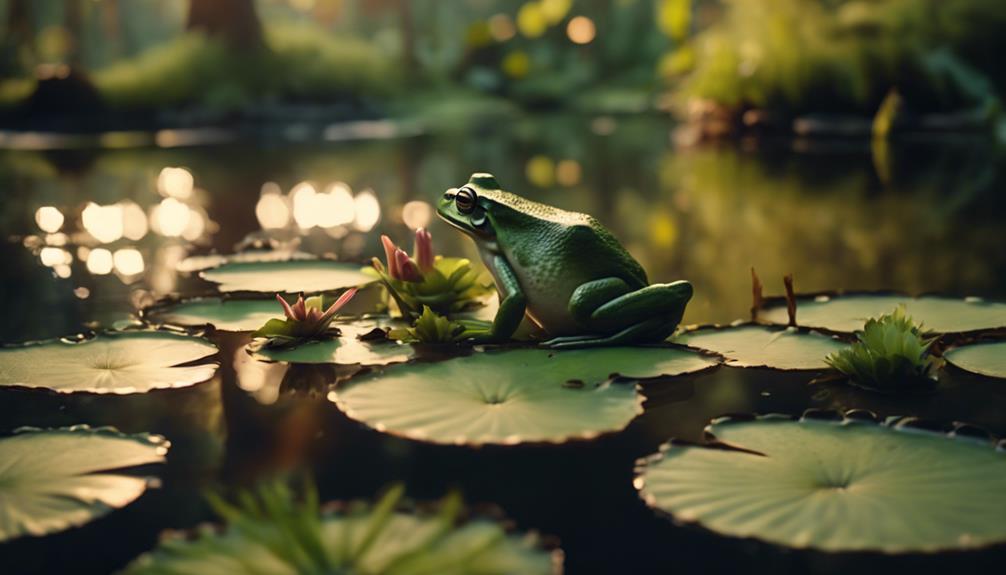
In Barstow Woods Park, you can observe various frog species like the American Bullfrog and Green Frog thriving in the park's wetlands and ponds. These amphibians play an essential role in the ecosystem, controlling insect populations and serving as prey for birds and other wildlife. You'll often hear their distinctive calls during spring and summer evenings, a clear indication of their active presence.
Understanding the frog life cycle is necessary for appreciating these creatures fully. Frogs undergo a fascinating metamorphosis, starting as eggs laid in clusters in the water. These hatch into tadpoles, which are entirely aquatic and breathe through gills. Over time, they develop legs, lose their tails, and their gills are replaced by lungs, evolving into adult frogs capable of living both in water and on land.
Delving into frog anatomy reveals how well-adapted they're for their dual life. Their powerful hind legs allow for impressive leaps, aiding in both predator evasion and prey capture. Their permeable skin, which can absorb water and oxygen, also makes them sensitive indicators of environmental health.
Given their ecological importance, frog conservation efforts are critical. Pollution, habitat destruction, and climate change pose significant threats to frog populations. By maintaining clean wetlands and protecting natural habitats, Barstow Woods Park contributes to these efforts, ensuring a safe environment for these amphibians.
Observing frogs in their natural habitat offers educational opportunities. You'll gain insights into their behavior, anatomy, and life cycle, enhancing your understanding of the delicate balance within ecosystems. So next time you're at the park, take a moment to appreciate these remarkable amphibians and their essential role in nature.
Turtles
You'll observe various turtle species, such as painted turtles and snapping turtles, basking in the sun along the park's ponds and wetlands.
The best viewing spots are near the water bodies where turtles swim gracefully.
Conservation efforts guarantee that these reptiles thrive and contribute to the park's rich biodiversity.
Native Turtle Species
Barstow Woods Park hosts three native turtle species—painted turtles, snapping turtles, and Blanding's turtles—that are often seen basking on logs and rocks near ponds and wetlands. These turtles play an important role in the park's ecosystem. Observing their natural behaviors provides insight into their daily lives and environmental contributions.
You'll notice that turtle nesting usually occurs in sandy or soft soil areas close to water. Female turtles dig nests to lay their eggs, which hatch after several weeks. Watching this nesting behavior can be a fascinating experience for park visitors.
Turtle behavior varies between species. Painted turtles are diurnal and can often be seen sunning themselves during the day. Snapping turtles, on the other hand, are more reclusive and prefer staying submerged, surfacing occasionally for air. Blanding's turtles are semi-aquatic and can be found both in water and on land.
Their feeding habits are diverse:
- Painted turtles: Primarily omnivorous, consuming aquatic vegetation, insects, and small fish.
- Snapping turtles: Carnivorous, feeding on fish, amphibians, and even small birds.
- Blanding's turtles: Omnivorous, with a diet including crustaceans, insects, and plant material.
Observing these turtles in their habitat offers a unique glimpse into their lives and the intricate balance of the park's ecosystem.
Best Viewing Spots
For essential turtle viewing, focus your attention on the ponds and wetland areas where these reptiles frequently bask and display a range of natural behaviors. You'll often spot painted turtles and snapping turtles along the edges of the ponds, sunning themselves on logs or rocks. These aquatic habitats offer excellent vantage points, especially from observation platforms or shaded areas near the water.
When observing, note the turtles' nesting sites, often found in sandy or soft soil near the water. Turtle nesting can be particularly fascinating in early summer when females lay their eggs. Watch for subtle movements and disturbances in these areas as indicators of nesting activity.
You'll also see turtles engage in feeding habits, primarily during the early morning and late afternoon. Painted turtles are omnivorous, consuming aquatic plants, insects, and small fish, while snapping turtles tend to be more carnivorous. Observing their feeding can offer insights into their diet and role in the ecosystem.
Lastly, pay attention to turtle interaction behaviors. Turtles often interact with each other through head bobbing, shell bumping, and even occasional territorial disputes. These behaviors are essential for understanding social structures within turtle populations in Barstow Woods Park.
Turtle Conservation Efforts
Efforts to conserve turtle populations at Barstow Woods Park focus on protecting their natural habitats and ensuring the sustainability of the species. The park's diverse ecosystems, including ponds and wetlands, are vital for various turtle species such as painted turtles and snapping turtles.
To bolster conservation, Barstow Woods Park employs several strategies:
- Turtle nesting protection: By safeguarding nesting sites, the park ensures that eggs have a higher chance of hatching. Barriers and signs are used to keep visitors from disturbing these critical areas.
- Turtle monitoring programs: Regular monitoring helps track turtle populations and health. Volunteers and park staff survey the park's ponds and wetlands, documenting turtle sightings and behaviors to gather essential data.
- Turtle rehabilitation efforts: Injured or sick turtles found in the park are taken to rehabilitation centers. Once they're healthy, they're released back into their natural habitats.
These initiatives are complemented by educational programs and informative signage throughout the park, raising public awareness about the importance of turtle conservation.
When you visit, you might spot turtles basking in the sun or gliding through the water, knowing that these efforts help ensure their continued presence in Barstow Woods Park.
Deer
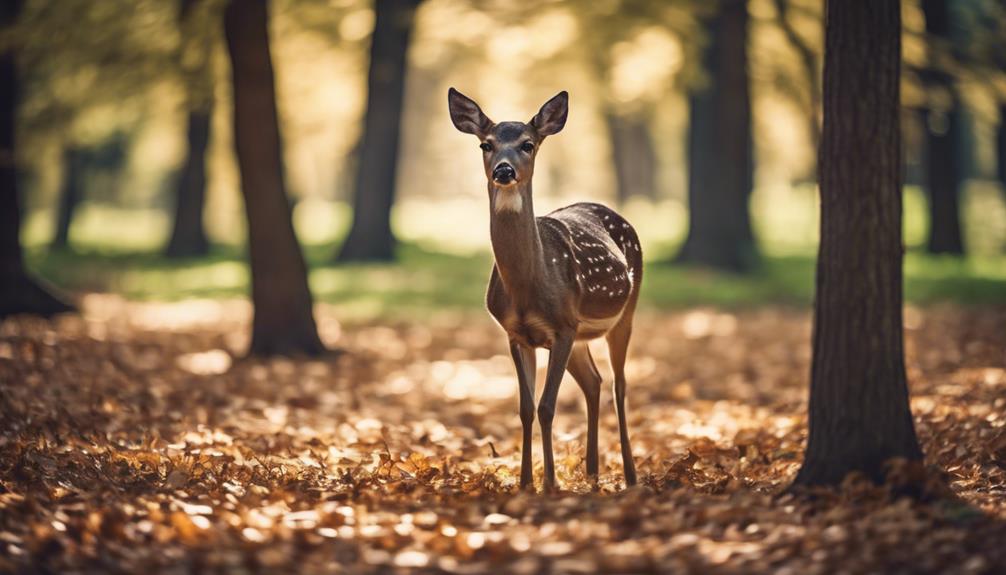
Have you ever noticed how the graceful movements of white-tailed and mule deer contribute to the serene ambiance of Barstow Woods Park? These deer are a common sight, often seen grazing in the open fields and wooded areas. Their behavior is fascinating to observe; they exhibit social structures where does and their fawns form small groups, while bucks tend to be more solitary, especially outside the mating season.
During twilight hours, you're more likely to encounter these deer as they come out to forage, taking advantage of the low light to stay hidden from predators.
Deer population management is essential for maintaining the balance within Barstow Woods Park. Without proper control, the deer population can grow unchecked, leading to overgrazing. This affects not only the health of the deer but also the entire ecosystem.
Park authorities often monitor the deer population through periodic counts and may implement controlled hunting or relocation programs to keep their numbers in check. These measures help to guarantee that the deer population remains sustainable and doesn't negatively impact the park's diverse flora and fauna.
The impact of deer on the ecosystem is profound. Their grazing habits can alter plant communities significantly, affecting the availability of food and habitat for other wildlife. For instance, overbrowsing by deer can lead to reduced plant diversity, which in turn can impact insects, birds, and other mammals.
As a result, understanding and managing deer behavior and population is essential for preserving the ecological balance of Barstow Woods Park. As you walk through the park, take a moment to appreciate these elegant creatures and the intricate role they play in the ecosystem.
Squirrels
Amidst the verdant expanse of Barstow Woods Park, Eastern gray squirrels and fox squirrels can be observed engaging in their energetic and resourceful behaviors. These agile creatures are a delight to watch, whether they're darting up trees or scurrying across the park grounds in search of food. You'll often see them foraging for nuts and seeds, an essential activity that not only sustains them but also contributes greatly to seed dispersal and ecosystem balance.
Squirrel behaviors in Barstow Woods Park are fascinating to observe. You might notice them burying nuts and seeds in preparation for the winter months. This behavior, known as caching, is critical for their survival during colder seasons when food is scarce. Additionally, their playful antics and acrobatics provide endless entertainment for park visitors.
Squirrel habitats within the park are diverse. They make their homes in tree cavities, leafy nests called dreys, and sometimes even underground burrows. The park's rich variety of trees and abundant food sources create an ideal environment for these industrious mammals. Observing their habitats can give you insight into their daily lives and survival strategies.
Efforts to conserve squirrel populations in Barstow Woods Park are ongoing. Conservation efforts focus on maintaining healthy habitats and ensuring a steady food supply.
You can contribute to these efforts by:
- Avoiding disturbing their nests: Respect their space to help them thrive.
- Not feeding them human food: This can disrupt their natural diet and behaviors.
- Supporting local conservation initiatives: Participate in or donate to programs aimed at preserving natural habitats.
Frequently Asked Questions
What Are the Best Times of Year to Visit Barstow Woods Park for Wildlife Spotting?
The best times to visit Barstow Woods Park for wildlife spotting are spring and fall. During these seasons, migration patterns peak, offering prime opportunities to observe a variety of species. Seasonal events like birdwatching tours can enhance your experience.
Visitor tips include arriving early for best sightings and bringing binoculars. Spring's blooming beauty and fall's foliage create a mesmerizing backdrop for your wildlife adventures.
Are There Guided Wildlife Tours Available at Barstow Woods Park?
Yes, there are guided wildlife tours available at Barstow Woods Park.
You can check the tour schedule online to find a time that suits you.
Tour guides are knowledgeable about the local ecosystem and will help you spot various wildlife.
Group sizes are usually kept small to guarantee a more intimate experience and better opportunities for observation.
Don't forget to book in advance, as spots can fill up quickly!
What Equipment Should I Bring for Wildlife Photography in the Park?
Imagine capturing nature's poetry with your lens. For stunning wildlife shots, bring a DSLR or mirrorless camera. Adjust your camera settings to high shutter speed for crisp images.
A sturdy tripod choice guarantees stability, especially in low light. Lens recommendations? Opt for a telephoto lens, ideally 300mm or more, to get those close-up details without disturbing the animals.
Happy shooting!
Are There Any Endangered Species in Barstow Woods Park?
Yes, there are endangered species in Barstow Woods Park. Conservation efforts focus on habitat restoration and species monitoring to protect these vulnerable populations.
You'll find that the park's initiatives aim to preserve the natural environment, ensuring that endangered species have a sustainable habitat.
Regular species monitoring helps track the health and numbers of these animals, providing vital data for ongoing conservation strategies.
Can I Bring My Dog to Barstow Woods Park While Wildlife Watching?
You're excited to bring your dog along, right? Well, let's explore it.
Dogs can join you, but here's the catch: leash regulations are strict. Your pet's behavior is vital; it should remain calm to avoid disturbing the wildlife. Pet etiquette matters—clean up after your dog and keep it from chasing animals.
Following these guidelines guarantees a harmonious experience for everyone involved.

